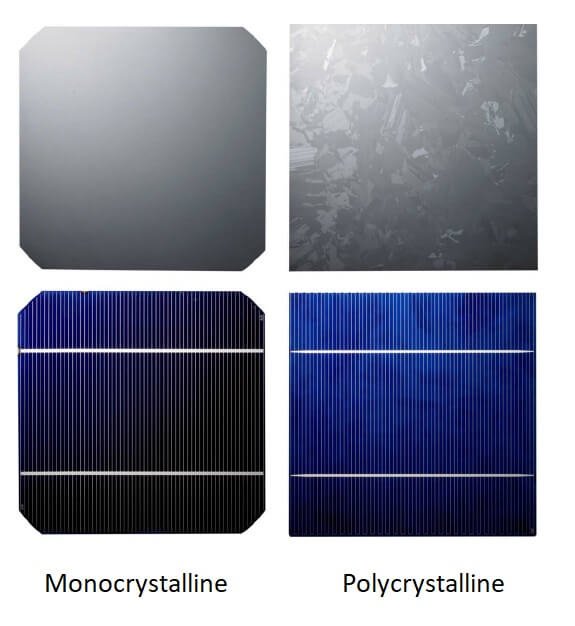The first step is to choose between the two solar panels – monocrystalline (mono) and polycrystalline (poly).
In this article, you will learn some key differences between monocrystalline and polycrystalline solar panels. Then, you can easily decide which one is best for your project.
Monocrystalline solar panels offer higher space and conversion efficiency, making them ideal for limited space areas but come at a higher cost. They have a uniform black appearance and are slightly more durable.
Polycrystalline solar panels are more cost-effective and suitable for larger installations where space isn’t a constraint, though they have slightly lower space efficiency. They feature a blue, speckled look and are slightly less durable than monocrystalline panels.
The choice between the two depends on your budget, space availability, and specific project requirements.
Check the comparison table between the two:
| Feature | Monocrystalline | Polycrystalline |
|---|---|---|
| Space Efficiency | Higher | Lower |
| Cost | More expensive | More cost-effective |
| Conversion Efficiency | Higher | Slightly lower |
| Aesthetics | Uniform black appearance | Blue, speckled appearance |
| Durability | Slightly more durable | Slightly less durable |
| Suitability | Limited space areas | Larger installations |

Monocrystalline Solar Panels (Mono)
- Space Efficiency: Monocrystalline panels are more space-efficient, producing more power per square foot than polycrystalline panels.
- Cost: Generally more expensive, but their higher space efficiency can make them a preferable choice where installation space is limited.
- Appearance and Durability: Typically, they have a uniform black color and are slightly more durable with a longer lifespan.
Polycrystalline Solar Panels (Poly)
- Cost Efficiency: While polycrystalline panels have lower space efficiency, they are often more cost-effective, offering a better price-to-performance ratio regarding overall power output.
- Appearance: Characterized by a blue, speckled look, which is less uniform than monocrystalline panels.
- Durability: Slightly less durable but still provides a long lifespan and reliable performance.
Key Considerations
- Installation Space: Monocrystalline panels are preferable in areas with limited space due to their higher efficiency.
- Budget: Polycrystalline panels can be a more budget-friendly choice, especially for larger installations where space is not a constraint.
- Overall Efficiency: “Efficiency” in solar panels often refers to how well they convert sunlight into electricity. Monocrystalline panels typically have a higher conversion efficiency, but polycrystalline panels can be more cost-effective.
Conclusion
Choose monocrystalline panels if space is limited or if you require higher conversion efficiency and are willing to invest more.
Opt for polycrystalline panels if you have more installation space and are looking for a more cost-effective solution.
FAQ
What is better, monocrystalline or polycrystalline?
Both are equally as good. Polycrystalline is just a bit bigger for the same power as monocrystalline.
Can you mix poly and mono solar panels?
If both panels have the same current but different voltage you can connect them in series.
If they have the same voltage, but different current you can connect them in parallel.
Read my article about wiring solar panels in series and parallel.
Is monocrystalline more expensive than polycrystalline?
Yes, monocrystalline is more expensive per watt because it uses another manufacturing method. That’s why I recommend using polycrystalline when space is not a constraint.

I’m an off-grid enthusiast. I created this website to give clear and straight-to-the-point advice about solar power. I’m also the author of the book ‘Off-grid solar power simplified‘. Read more about me on my about page, check out my Youtube channel, or send me a message.